Shot blasting is a powerful surface treatment technique used to clean, deburr, and prepare various materials for further processing. This comprehensive guide will delve into the intricacies of this process, exploring its mechanics, benefits, different types, safety precautions, and diverse applications.
Understanding the Shot Blasting Process: A Step-by-Step Guide
The shot blasting process involves propelling small, hard abrasive particles (typically steel shot, cast iron shot, or other suitable media) at high velocity onto a workpiece’s surface. This high-impact bombardment achieves several crucial results, including:
- Cleaning: Removing dirt, rust, scale, paint, and other surface contaminants.
- Deburring: Smoothing sharp edges and removing burrs from machined parts.
- Surface Roughening: Creating a textured surface ideal for improved paint adhesion or other coatings.
- Stress Relieving: In some cases, shot blasting can help relieve residual stresses in the material.
The process typically involves a shot blasting machine that houses a wheel or turbine to accelerate the abrasive media. This media is then directed towards the workpiece, which is often mounted on a rotating fixture to ensure even coverage. After blasting, the spent media is collected and recycled, minimizing waste and maximizing efficiency.
Types of Shot Blasting Machines: Tailoring the Process to Your Needs
Several types of shot blasting machines cater to different applications and workpiece sizes. These include:
- Wheel Blast Machines: These utilize a rotating wheel to propel the abrasive media, offering high impact and throughput, suitable for large-scale operations.
- Air Blast Machines: Employing compressed air to propel the media, these machines are more versatile and can handle intricate parts. They offer greater control over the blasting intensity.
- Tumble Blast Machines: Ideal for smaller parts, these machines rotate the workpieces within a blasting chamber, ensuring even media coverage.
- Automated Blast Machines: Designed for high-volume production, these systems often incorporate robotic arms and advanced controls for precise and efficient blasting.
The choice of machine depends heavily on factors like the size and shape of the workpieces, the desired surface finish, production volume, and budget.
Benefits of Shot Blasting: Enhancing Quality and Efficiency
Shot blasting offers a multitude of advantages over other surface treatment methods, including:
- Superior Cleaning: Achieves a level of cleanliness unmatched by manual methods, ensuring optimal surface preparation.
- Increased Productivity: Automates the cleaning process, significantly increasing throughput compared to manual cleaning.
- Improved Coating Adhesion: Creates a textured surface that promotes better adhesion of paints, coatings, and other surface treatments.
- Enhanced Durability: The process can improve the fatigue strength and overall durability of the workpiece.
- Cost-Effectiveness: While the initial investment can be significant, the long-term cost savings due to increased efficiency and reduced labor costs make it a worthwhile investment.
These benefits contribute to improved product quality, reduced production time, and ultimately, enhanced profitability.
Shot Blasting Safety Procedures: Prioritizing Worker Well-being
Shot blasting, while highly effective, presents potential hazards if safety protocols are not strictly followed. Crucial safety measures include:
- Proper Personal Protective Equipment (PPE): Operators must wear safety helmets, eye protection, respirators, hearing protection, and protective clothing to mitigate the risks of injury from flying debris, noise, and dust.
- Enclosure and Containment: Shot blasting should ideally be performed within an enclosed chamber to contain the abrasive media and dust, minimizing environmental impact and worker exposure.
- Regular Machine Maintenance: Routine maintenance of the shot blasting equipment is crucial to prevent malfunctions and ensure safe operation.
- Operator Training: Thorough training on safe operating procedures is essential for all personnel involved in the shot blasting process.
- Emergency Procedures: Clear emergency procedures should be established and communicated to all personnel to handle any unforeseen incidents.
Adhering to these safety measures is paramount to ensuring the well-being of workers and preventing accidents.
Applications of Shot Blasting: A Wide Range of Industries
Shot blasting finds applications across a broad spectrum of industries, including:
- Automotive: Cleaning and preparing car bodies for painting.
- Aerospace: Cleaning and preparing aircraft components.
- Construction: Cleaning and preparing steel structures.
- Manufacturing: Deburring and cleaning various metal parts.
- Marine: Cleaning and preparing ship hulls and components.
- Railroad: Cleaning and preparing railway carriages and tracks.
The versatility of shot blasting makes it an indispensable process in numerous manufacturing and industrial applications.
In conclusion, shot blasting is a powerful and versatile surface treatment technique that offers significant benefits in terms of cleaning, deburring, and surface preparation. Understanding the process, its various types, safety procedures, and wide-ranging applications is crucial for maximizing its effectiveness and ensuring a safe working environment.
SEO Tags:
Shot blasting, abrasive blasting, surface preparation, metal cleaning, industrial cleaning




